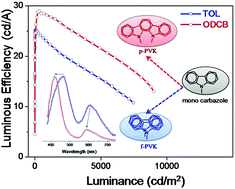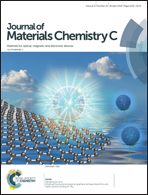The application of a high boiling point dissolution solvent on a poly(N-vinylcarbazole) host toward improving the performance of blue electrophosphorescent devices via a solution process†
Abstract
The photophysics and charge transport properties of polymer host materials largely determine the resultant electroluminescent (EL) performance of solution-processed phosphorescent organic light-emitting diodes (s-PhOLEDs). Herein, these characteristics of the state-of-the-art polymer host material, i.e. poly(N-vinylcarbazole) (PVK), are manipulated via the choice of the processing solvent by means ofdifferent boiling points. Compared to the control PVK film (toluene as solvent), the PVK film with a high packing density processed with o-dichlorobenzene (ODCB) solvent displays a higher excitonic energy, i.e. the more the “p-PVK” contribution, the lower the content of low energy PVK electromers under EL driving, and also a different hole transport capability. For the PVK:FIrpic doped film, it is confirmed that the host-to-guest energy transfer efficiency is the best for the ODCB based film among these samples. PVK:FIpric doped s-PhOLEDs are comparatively fabricated by using these solvents, and the ODCB based device achieves a high luminous efficiency of 29.0 cd A−1, corresponding to 16% enhancement with respect to 25 cd A−1 of the control TOL device. Such performance promotion is attributed to the satisfied energy transfer process from PVK to FIrpic and also the enhanced charge balance conditions achieved in the ODCB device.



 Please wait while we load your content...
Please wait while we load your content...